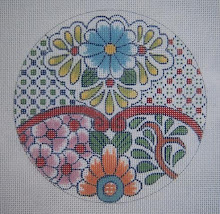 I saw this pretty fabric as a patch on a quilt somewhere on the internet, and thought it was interesting that it has one more element added to what we normally think of as "gingham checks," as it has yellow added to what we usually see as just one color plus white. (which makes a lighter shade of the color where it crosses the white) I decided to adapt it to needlepoint to show what an easy thing it is!
I saw this pretty fabric as a patch on a quilt somewhere on the internet, and thought it was interesting that it has one more element added to what we normally think of as "gingham checks," as it has yellow added to what we usually see as just one color plus white. (which makes a lighter shade of the color where it crosses the white) I decided to adapt it to needlepoint to show what an easy thing it is! People have asked what is the difference between "gingham" and "plaid." Gingham originally came from a Malaysian/French word meaning "stripes." Later, it came to mean a cloth made of cotton that has been dyed before weaving instead of being printed with color patterns afterward or dyed after it's taken off the loom whether or not it has stripes
.
"Plaid" is derived from a Gaelic word meaning "sheep skin," which is logical, as the early fabrics in the region where the plaid was first found (Scottish Highlands) were wool. The word "tartan" is applied to numerous textile patterns consisting of stripes of varying widths and colors, crossed at right angles against a solid background - each forming a distinctive design. It is these patterns that have been adopted by individual Highland families as their own - and now, even different countries and states in the U.S.A. have their own tartans.
In this era, "plaid" is the name applied to the tartan patterns, so gingham is actually a woven plaid - a very simple form. The Rob Roy family tartan is a "giant" gingham check, as it is composed of two colors only, red and black, in large stripes of equal widths. In my mind, the term "gingham checks" means those pretty fabrics we used to wear ourselves as children - and I delighted in sewing dresses for my daughters with "baby gingham." The fabric was, again, just one color plus white, with a lighter shade of the color where it crossed white in the weave.
Anyway, on Freebies in a little while, I'll do a post on setting up this simple plaid, as it's a foundation for doing more elaborate plaids (tartans, to be correct), and you can see how very easy it is to do. Remember that there is more to creating plaids than just "setting them up." When using them for individual projects, the size and scale must be considered - one wouldn't want to make a large pillow border with tiny little checks!! Also, you can see how easy it is to just widen or make narrower a stripe, add another color or two, and create your own original pattern!!
ADDENDUM: I do have a book on this, available on my web page, Elegant Whimsies - and very soon to be an e-book you can download for yourself.

5 comments:
Great explanation! While I am not planning on doing any of these anytime soon, it is nice to know there is a source for the how to!
Interesting to read your comment that "plaid" is the name applied to tartans these days. I don't think I have ever heard anyone use "plaid", though of course I see it all the time on websites etc. We tend to use "tartan" here -
I wonder if this is yet another example of USA v UK/Austr/NZ useage? And which word do Canadians use - do they follow their North American neighbours, or UK useage?
You are correct - that is a U.S.A. usage of the word. The "plaid" is the name of the long, rectangular scarf over the shoulder that's worn with the kilt. I changed to the U.S.A. terminology in the Freebies post to eliminate the confusion for the people who read it here. "Tartan" is the correct name for what we call "plaid." I don't know what the Canadians use - I'll have to ask.
I worked a needlepoint project once that called for a plaid design done in red, yellow, brown. It turned out really well - had a scottish look to it...
Carolyn
http://www.stitchopedia.com
An encyclopedia of needlepoint stitches…
Thanks for the explanation of the definitions...the look is visibly different to me.This fabric is nice to be used as a patch of a quilt.
quilt
Post a Comment